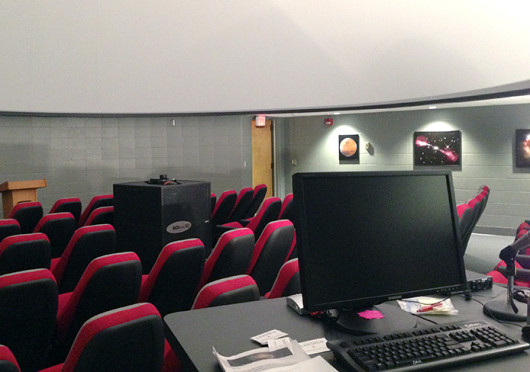
The renovated OSU Planetarium, located on the 5th floor of Smith Laboratory, has 63 seats and a Spitz SciDome XD projection system.
Credit: Cameron Roda / Lantern reporter
Those looking for a low-budget galaxy getaway can now head to the center of Ohio State’s campus.
The Ohio State Planetarium reopened Saturday, drawing some people eager for an afternoon of stargazing.
The OSU Department of Astronomy hosted audiences for free from 1 p.m. to 9 p.m. with 16 half hour long shows. The Department of Astronomy received more than 850 reservations for the planetarium’s grand reopening through its website, according to director of the OSU planetarium Catherine Grier.
The newly renovated planetarium on the fifth floor of Smith Laboratory features a brand new Spitz SciDome XD projection system. The planetarium presentation, which lasted about 20 minutes, showcased stars and constellations in the night sky that are not visible in Columbus because of the light pollution given off by the city.
The renovations cost the department $620,000, almost half of which came from leftover funds from within the College of Arts and Sciences. Other funds were contributed to the project from the Astronomy Department, the College of Arts and Sciences and donations, Grier said.
The show took the audience to different parts of the Earth to view the night sky, then flew through the solar system to see a view of the night sky from Saturn’s moon Tethys.
Viewers saw galaxies in the night sky which were represented by faint hues of light, then were thrust 240 million light years away to see the Milky Way Galaxy as a dot in a cluster of galaxies.
Grier said the new projection system at the OSU Planetarium differs tremendously from the previous system.
“This one has two digital projectors with fish-eye (lenses) on them, so instead of a big, mechanical star ball which is what we had before, this is all digital,” Grier said. “The whole thing is run with computers now. Two projectors each project a half-dome and work together.”
The new projection system replaced the planetarium’s former Spitz A3P opto-mechanical star ball, installed at OSU in 1967, Grier said. The system featured more than 1,500 stars and could show the full range of solar and lunar cycles, according to the Department of Astronomy’s website.
The star ball projector, which cost the university $19,500 at the time, Grier said, was donated by the department to the Perkins Observatory in Delaware, Ohio.
Other renovations during the 16-month closure of the OSU Planetarium included fixing a leaking roof and replacing the dome inside the theater, Grier said.
The new 30-foot dome hosts a high-definition 2560 by 2560 pixel resolution from the new projection system, she said.
The renovations were capped off with the installment of 63 new theater-style seats, slightly tilted back to give viewers a full look at the projection, Grier said.
Associate astronomy professor Jennifer Johnson said she is excited to use the planetarium for her astronomy courses.
“The new planetarium will have a big impact. We are planning a new overview course of astronomy that will have a lab,” Johnson said. “We can stretch our students’ imagination so much more because we can view the universe in many more ways.”
Johnson said the labs will use the planetarium as a part of the course curriculum.
The Department of Astronomy will begin offering free shows to students and the general public in November, Grier said.


